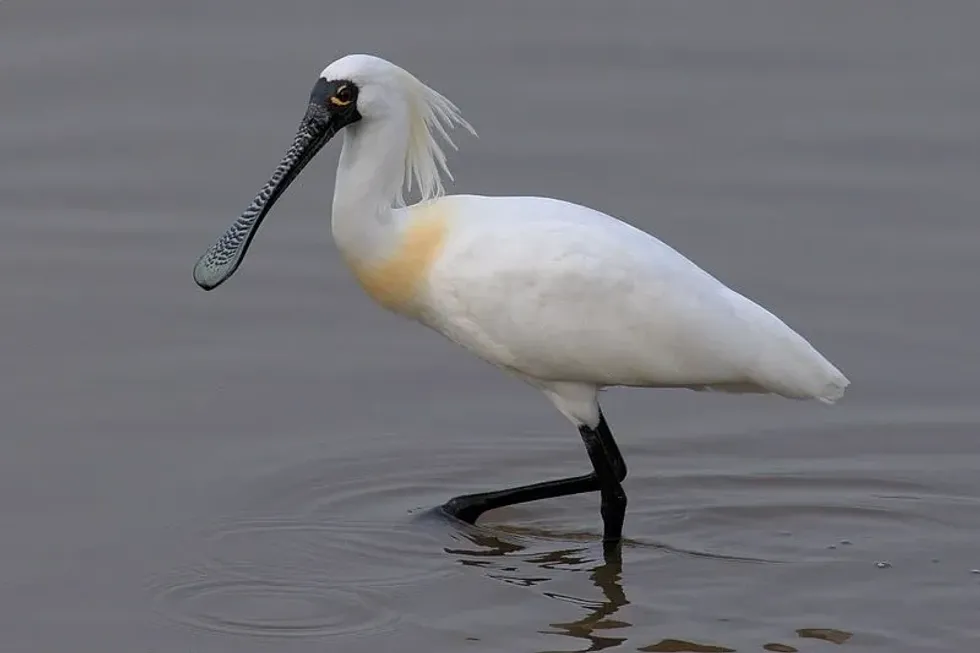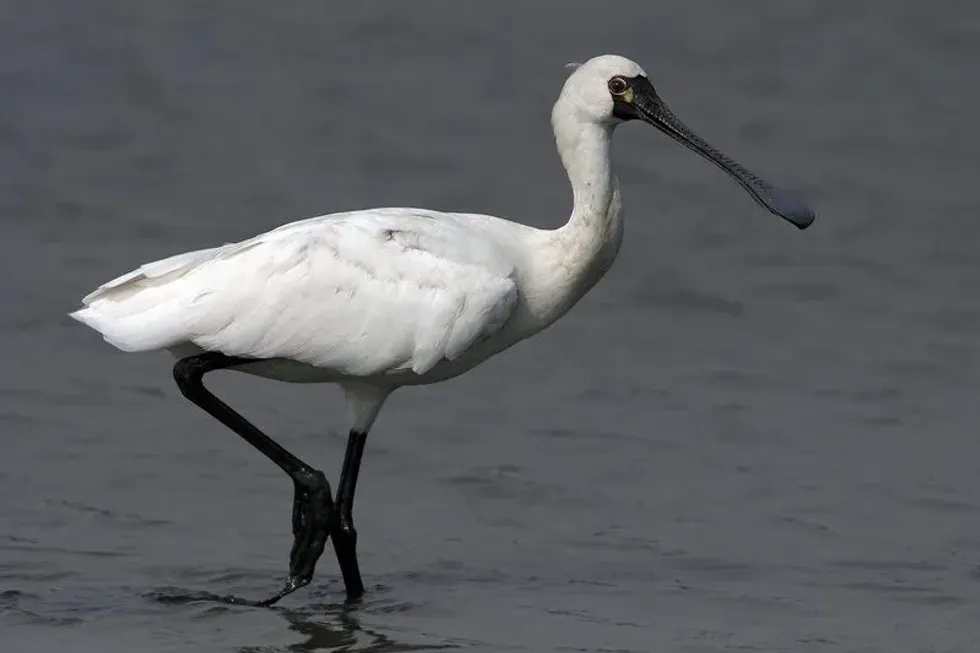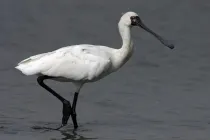Fun Black-faced Spoonbill Facts For Kids

Today we are going to learn about these magnificent white birds with a black face, black legs, and a dark gray or black bill.
Black-faced spoonbills are native mainly to the range of eastern Asia, where their breeding areas are the islands on the western coasts of the Korean Peninsula and the Liaoning province of China.
On the other hand, these migratory birds spend their winters in Macau, Taiwan, Hong Kong, and Vietnam, as well as in South Korea, Japan, Vietnam and the Pearl River Delta area which includes Mai Po and Inner Deep Bay, Macau, and the Futian Nature Reserve.
Apart from East Asian countries, they are also spotted in Thailand and the Philippines.
These birds are mainly found in coastal areas and shallow water bodies. They have a unique and goofy way of black-faced spoonbill foraging with the help of their long and flat spoon-like bills.
The population of black-faced spoonbills was estimated to be 288 individuals according to a winter survey published in 1988-1990. Conservation measures were implemented, and by 2006, the estimated worldwide population had grown to 1679.
This endangered species present number is around 3941 individuals, according to the most recent census, and their numbers are growing. Although the population of this species is increasing, it has been listed as Endangered by the International Union for Conservation of Nature (IUCN) Red List.
Read on to know more about these birds. If you like this article, check out our other articles on the night heron and pelican.
Black-Faced Spoonbill Interesting Facts
What type of animal is a black-faced spoonbill?
The black-faced spoonbill (Platalea minor) is a type of water bird that belongs to the Pelecaniformes order.
What class of animal does a black-faced spoonbill belong to?
The black-faced spoonbill (Platalea minor) belongs to the Aves class. Among the other six spoonbill species in the Threskiornithidae family, this species has the most restricted distribution.
How many black-faced spoonbills are there in the world?
According to a winter survey conducted in 1988-1990, the global population of black-faced spoonbill was estimated to be 288 individuals. However, international conservation measures were made and by 2006, the projected global population had increased to 1679. According to the most recent census, there are roughly 3941 individuals of this species and they are increasing in number.
Where does a black-faced spoonbill live?
The black-faced spoonbill (Platalea minor) is a migratory bird that has its habitat along the coastal region of East Asia. The nesting season of this wading bird is spent on the western coasts of the Korean Peninsula from March to September.
This includes areas of small rocky islands off the west coast of North Korea and the Liaoning province of China.
Their most famous nesting ground is in the Demilitarized Zone (DMZ) between North and South Korea where human access is prohibited.
The wintering sites of this species range across Macau, Taiwan, Hong Kong, and Vietnam, as well as in South Korea, Japan, Vietnam, and the Pearl River Delta area which includes Mai Po and Inner Deep Bay, Macau, and Futian Nature Reserve. Furthermore, they are also spotted in Thailand and the Philippines.
What is a black-faced spoonbill's habitat?
This species of wading bird lives in shallow water bodies like marshes, fish ponds, seashores, wet rice fields, and coastal areas near fish farms.
Who do black-faced spoonbills live with?
There is a scarcity of data about the social behavior of these birds. There are some spoonbill species that are mainly solitary when foraging for food. However, during the breeding and winter seasons, they become gregarious and migrate in flocks.
How long does a black-faced spoonbill live?
In the wild, the maximum lifespan of a bird of this species is recorded at about nine and a half years.
How do they reproduce?
There is not enough information about the mating habits of this species. The breeding season of this species is from March to August on the small islands on the west coast of North Korea and South Korea as well as the Liaoning province of China.
These birds first breed when they are five years old. After copulation, they make nests with twigs and lay two to three eggs in them. The incubation is mainly done by the female but the males sometimes offer assistance.
After the chicks hatch from the eggs, both parents provide them with great care. They begin to fledge after four to six weeks and become independent.
What is their conservation status?
Despite the growth in the population of black-faced spoonbills, these birds still remain marked as Endangered by the International Union for Conservation of Nature (IUCN) Red List.
They have a restricted distribution and since they have a mere 3941 global population, they face a threat of extinction in the future, mainly due to habitat destruction, pollution, and climate change.
Therefore, black-faced spoonbill conservation has become a priority where measures are taken to preserve and secure their breeding area, make their habitat pollution-free, free of human disturbances, and protect them from infections.
A very important measure that has been taken by the management of WWF is maintaining the gei wai of the Mai Po where these birds regularly roost and feed themselves.
Black-Faced Spoonbill Fun Facts
What does a black-faced spoonbill look like?
The black-faced spoonbill (Platalea minor) is a large bird with white plumage, a black face, black legs, and a dark gray or black bill, thus obtaining its name. The tips of their white wings are black. Their beak is long and flat, like a spoon or the Chinese instrument known as pi-pa. Young ones have pinkish-brown bills.

How cute are they?
Black-faced spoonbills are extremely adorable waterbirds like the American tree sparrow. Bird watchers are drawn to them because of the way they fly by flapping their wings and extending their neck and legs.
How do they communicate?
There is not much information about the communication of this water bird except the fact that their calls sound like 'ubuu ubuu'. However, other spoonbills like Roseate spoonbills are known to utter a low croaky sound when they are feeding, mating, and flying.
How big is a black-faced spoonbill?
The height of a black-faced spoonbill (Platalea minor) is 30 in (76 cm), which is twice the size of an Argentine lake duck.
How fast can a black-faced spoonbill fly?
The speed of this majestic black-faced spoonbill is unknown due to a lack of information. However, it is known that these are migratory birds who travel south during the winter to protect themselves from the harsh weather.
How much does a black-faced spoonbill weigh?
The black-faced spoonbill (Platalea minor) is a waterbird that weighs around 3 lb (1.2 kg).
What are the male and female names of the species?
The males of all bird species all over the world are called cocks, and females are called hens. However, there are no specific labels for the different genders of the black-faced spoonbill.
What would you call a baby black-faced spoonbill?
A baby black-faced spoonbill is called a chick.
What do they eat?
This species inhabit the shallow coastal areas around the seashores, estuaries, and fish ponds feeding mainly on small fish and shrimp. This species, like most spoonbills, has a unique way of catching their prey.
They sweep through the water with their spoon-shaped bill partially open and moving them side to side to grasp prey. Predators of black-faced spoonbills include cats, raccoons, and also possibly great eagle owls.
Are they poisonous?
No, these birds are not at all poisonous in nature, neither do they tend to pose any threat to humans. However, spoonbills are quite aggressive during the breeding season and while defending their territories.
Would they make a good pet?
No, these are wild waterbirds who hunt for themselves and therefore should not be domesticated.
Did you know...
When a few spoonbills have gathered together, the group is known as a 'bowl' of spoonbills.
These birds are closely related to royal spoonbills, according to DNA tests.
How many species of spoonbills are there?
There are six species of spoonbills all over the world in the Threskiornithidae family and genus Platalea. The most distinguishing feature about the birds of this species is their flat, long and spatulate bills. They are the Eurasian spoonbill or common spoonbill, African Spoonbill, royal spoonbill, Roseate spoonbill, yellow-billed spoonbill, and black-faced spoonbill.
The black-faced spoonbill, on the other hand, is the only endangered spoonbill and has the most restricted distribution among all the species.
Are black-faced spoonbills endangered?
Even though their population has increased throughout the last few years, these birds are still listed as Endangered by the International Union for Conservation of Nature (IUCN) Red List.
They are facing a population decline because of the destruction of their breeding and wintering sites as a result of deforestation and the growth of human-made industries on account of development.
The Korean war which lasted from 1950 to 1953 also played a major role in their decline since these birds stopped nesting in their South Korean range at that time. Their nesting sites in Japan also saw a massive decline and as few as five birds were spotted since that time.
The population of these wading birds are expected to suffer more declines in the future, putting them on the brink of extinction if there are not enough measures taken.
Hunting is not a major threat to the population of black-faced spoonbills in South Korea, Japan, and Taiwan, which may be why they are not included in the South Korean hunting ban.
However, they are a problem in Russia, China, and Vietnam. A very important measure that has been taken by the management of WWF is maintaining the gei wai of the Mai Po where these birds regularly roost and feed themselves.
Apart from that, black-faced spoonbills are legally protected in Taiwan, China, North Korea, South Korea, and Japan.
North Korea has protected the breeding sites of these birds seabird sanctuaries and China has made the breeding sites non-hunting areas to protect these wild wading birds. Their nesting islands in North Korea are announced as a Zone of Protection and have restricted access.
On the other hand, a few wintering sites which are protected are the Tainan National Park in Taiwan and Inner Deep Bay, and Mai Po in Hong Kong.
Here at Kidadl, we have carefully created lots of interesting family-friendly animal facts for everyone to discover! Learn more about some other birds from our ovenbird facts and umbrellabird facts pages.
You can even occupy yourself at home by coloring in one of our free printable black faced spoonbill coloring pages.
We Want Your Photos!
More for You
See All
Bachelor of Arts specializing in Journalism and Mass Communication, Postgraduate Diploma in Sports Management

Moumita DuttaBachelor of Arts specializing in Journalism and Mass Communication, Postgraduate Diploma in Sports Management
A content writer and editor with a passion for sports, Moumita has honed her skills in producing compelling match reports and stories about sporting heroes. She holds a degree in Journalism and Mass Communication from the Indian Institute of Social Welfare and Business Management, Calcutta University, alongside a postgraduate diploma in Sports Management.
Bachelor of Arts specializing in English Literature, Masters of Art specializing in English and Communication Skills

Sonali RawatBachelor of Arts specializing in English Literature, Masters of Art specializing in English and Communication Skills
Sonali has a Bachelor's degree in English literature from Guru Gobind Singh Indraprastha University and is currently pursuing a Master's in English and Communication from Christ University. With considerable experience in writing about lifestyle topics, including travel and health, she has a passion for Japanese culture, especially fashion, and anime, and has written on the subject before. Sonali has event managed a creative-writing festival and coordinated a student magazine at her university. Her favorite authors are Toni Morrison and Anita Desai.
Disclaimer
1) Kidadl is independent and to make our service free to you the reader we are supported by advertising. We hope you love our recommendations for products and services! What we suggest is selected independently by the Kidadl team. If you purchase using the Buy Now button we may earn a small commission. This does not influence our choices. Prices are correct and items are available at the time the article was published but we cannot guarantee that on the time of reading. Please note that Kidadl is a participant in the Amazon Services LLC Associates Program, an affiliate advertising program designed to provide a means for sites to earn advertising fees by advertising and linking to Amazon. We also link to other websites, but are not responsible for their content.
2) At Kidadl, we strive to recommend the very best activities and events. We will always aim to give you accurate information at the date of publication - however, information does change, so it’s important you do your own research, double-check and make the decision that is right for your family. We recognise that not all activities and ideas are appropriate for all children and families or in all circumstances. Our recommended activities are based on age but these are a guide. We recommend that these ideas are used as inspiration, that ideas are undertaken with appropriate adult supervision, and that each adult uses their own discretion and knowledge of their children to consider the safety and suitability. Kidadl cannot accept liability for the execution of these ideas, and parental supervision is advised at all times, as safety is paramount. Anyone using the information provided by Kidadl does so at their own risk and we can not accept liability if things go wrong.
3) Because we are an educational resource, we have quotes and facts about a range of historical and modern figures. We do not endorse the actions of or rhetoric of all the people included in these collections, but we think they are important for growing minds to learn about under the guidance of parents or guardians.







